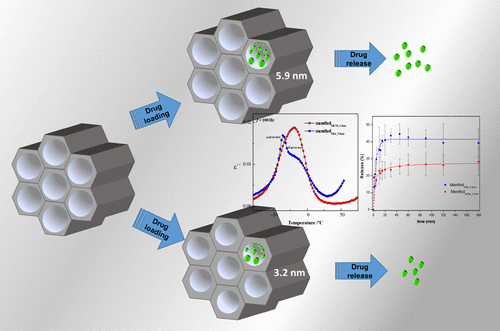当前位置:
X-MOL 学术
›
Mol. Pharmaceutics
›
论文详情
Our official English website, www.x-mol.net, welcomes your
feedback! (Note: you will need to create a separate account there.)
Stabilizing Unstable Amorphous Menthol through Inclusion in Mesoporous Silica Hosts
Molecular Pharmaceutics ( IF 4.5 ) Pub Date : 2017-08-24 00:00:00 , DOI: 10.1021/acs.molpharmaceut.7b00386 Teresa Cordeiro 1 , Carmem Castiñeira 2 , Davide Mendes 1 , Florence Danède 3 , João Sotomayor 1 , Isabel M. Fonseca 1 , Marco Gomes da Silva 1 , Alexandre Paiva 1 , Susana Barreiros 1 , M. Margarida Cardoso 1 , Maria T. Viciosa 4 , Natália T. Correia 3 , Madalena Dionisio 1
Molecular Pharmaceutics ( IF 4.5 ) Pub Date : 2017-08-24 00:00:00 , DOI: 10.1021/acs.molpharmaceut.7b00386 Teresa Cordeiro 1 , Carmem Castiñeira 2 , Davide Mendes 1 , Florence Danède 3 , João Sotomayor 1 , Isabel M. Fonseca 1 , Marco Gomes da Silva 1 , Alexandre Paiva 1 , Susana Barreiros 1 , M. Margarida Cardoso 1 , Maria T. Viciosa 4 , Natália T. Correia 3 , Madalena Dionisio 1
Affiliation

|
The amorphization of the readily crystallizable therapeutic ingredient and food additive, menthol, was successfully achieved by inclusion of neat menthol in mesoporous silica matrixes of 3.2 and 5.9 nm size pores. Menthol amorphization was confirmed by the calorimetric detection of a glass transition. The respective glass transition temperature, Tg = −54.3 °C, is in good agreement with the one predicted by the composition dependence of the Tg values determined for menthol:flurbiprofen therapeutic deep eutectic solvents (THEDESs). Nonisothermal crystallization was never observed for neat menthol loaded into silica hosts, which can indicate that menthol rests as a full amorphous/supercooled material inside the pores of the silica matrixes. Menthol mobility was probed by dielectric relaxation spectroscopy, which allowed to identify two relaxation processes in both pore sizes: a faster one associated with mobility of neat-like menthol molecules (α-process), and a slower, dominant one due to the hindered mobility of menthol molecules adsorbed at the inner pore walls (S-process). The fraction of molecular population governing the α-process is greater in the higher (5.9 nm) pore size matrix, although in both cases the S-process is more intense than the α-process. A dielectric glass transition temperature was estimated for each α (Tg,dielc(α)) and S (Tg,dielc(S)) molecular population from the temperature dependence of the relaxation times to 100 s. While Tg,dielc(α) agrees better with the value obtained from the linearization of the Fox equation assuming ideal behavior of the menthol:flurbiprofen THEDES, Tg,dielc(S) is close to the value determined by calorimetry for the silica composites due to a dominance of the adsorbed population inside the pores. Nevertheless, the greater fraction of more mobile bulk-like molecules in the 5.9 nm pore size matrix seems to determine the faster drug release at initial times relative to the 3.2 nm composite. However, the latter inhibits crystallization inside pores since its dimensions are inferior to menthol critical size for nucleation. This points to a suitability of these composites as drug delivery systems in which the drug release profile can be controlled by tuning the host pore size.
中文翻译:

通过包容在介孔二氧化硅主体中稳定不稳定的非晶态薄荷醇
易于结晶的治疗成分和食品添加剂薄荷醇的非晶化是通过在3.2和5.9 nm孔径的中孔二氧化硅基质中加入纯薄荷醇而成功实现的。通过量热检测玻璃化转变证实了薄荷醇非晶化。各自的玻璃化转变温度T g = -54.3°C,与通过T g的成分依赖性预测的温度非常吻合薄荷醇:氟比洛芬治疗性深共晶溶剂(THEDESs)的测定值。从未观察到装载到二氧化硅基质中的纯薄荷醇的非等温结晶,这表明薄荷醇以完全无定形/过冷的物质形式存在于二氧化硅基质的孔中。通过介电弛豫光谱技术检测薄荷醇的迁移率,该方法可以确定两种孔径的两个弛豫过程:与纯净薄荷醇分子的迁移率相关的较快弛豫过程(α过程),以及由于迁移率受阻而较慢的占主导地位的过程。吸附在内部孔壁上的薄荷醇分子的数量(S过程)。在较高的孔径(5.9 nm)基质中,控制α过程的分子种群分数更大,尽管在两种情况下S过程都比α过程更强烈。T g,dielc(α))和S(T g,dielc(S))分子种群从弛豫时间的温度依赖性到100 s。虽然Ť克,dielc(α)同意从Fox方程假设薄荷醇的理想行为的线性化所获得的值更好:氟比洛芬THEDES,Ť克,dielc(S)由于孔隙内部的吸附种群占主导地位,该值接近于通过量热法确定的二氧化硅复合材料的值。然而,相对于3.2 nm复合材料,在5.9 nm孔径的基质中,较大部分的更具流动性的块状分子似乎决定了药物在初始时间的释放速度更快。然而,后者抑制了孔内的结晶,因为其尺寸小于薄荷醇临界成核尺寸。这表明这些复合材料适合作为药物输送系统,其中可以通过调节宿主的孔径来控制药物释放曲线。
更新日期:2017-08-24
中文翻译:

通过包容在介孔二氧化硅主体中稳定不稳定的非晶态薄荷醇
易于结晶的治疗成分和食品添加剂薄荷醇的非晶化是通过在3.2和5.9 nm孔径的中孔二氧化硅基质中加入纯薄荷醇而成功实现的。通过量热检测玻璃化转变证实了薄荷醇非晶化。各自的玻璃化转变温度T g = -54.3°C,与通过T g的成分依赖性预测的温度非常吻合薄荷醇:氟比洛芬治疗性深共晶溶剂(THEDESs)的测定值。从未观察到装载到二氧化硅基质中的纯薄荷醇的非等温结晶,这表明薄荷醇以完全无定形/过冷的物质形式存在于二氧化硅基质的孔中。通过介电弛豫光谱技术检测薄荷醇的迁移率,该方法可以确定两种孔径的两个弛豫过程:与纯净薄荷醇分子的迁移率相关的较快弛豫过程(α过程),以及由于迁移率受阻而较慢的占主导地位的过程。吸附在内部孔壁上的薄荷醇分子的数量(S过程)。在较高的孔径(5.9 nm)基质中,控制α过程的分子种群分数更大,尽管在两种情况下S过程都比α过程更强烈。T g,dielc(α))和S(T g,dielc(S))分子种群从弛豫时间的温度依赖性到100 s。虽然Ť克,dielc(α)同意从Fox方程假设薄荷醇的理想行为的线性化所获得的值更好:氟比洛芬THEDES,Ť克,dielc(S)由于孔隙内部的吸附种群占主导地位,该值接近于通过量热法确定的二氧化硅复合材料的值。然而,相对于3.2 nm复合材料,在5.9 nm孔径的基质中,较大部分的更具流动性的块状分子似乎决定了药物在初始时间的释放速度更快。然而,后者抑制了孔内的结晶,因为其尺寸小于薄荷醇临界成核尺寸。这表明这些复合材料适合作为药物输送系统,其中可以通过调节宿主的孔径来控制药物释放曲线。










































 京公网安备 11010802027423号
京公网安备 11010802027423号